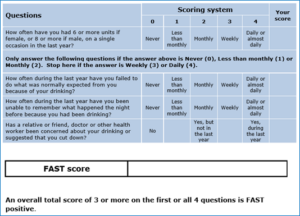There is continuous research into the harms of alcohol, and as new research is undertaken, the guidelines and advice around alcohol consumption have changed.
The current recommendations is that men and women are advised not to drink more than 14 units a week on a regular basis, to spread drinking over three or more days if regularly drinking as much as 14 units a week, and having several drink-free days each week.
Alcohol units express the quantity of pure alcohol in a drink. One unit equals 10ml or 8g of pure alcohol, which is around the amount of alcohol an average adult can process in an hour (although this varies from person-to-person). The number of units in a drink is based on the size of the drink as well as its alcohol strength. The units can be calculated using the standard measure alcohol by volume (ABV) which is a measure of the amount of pure alcohol as a percentage of the total volume of liquid in a drink. For example, if wine is 12% ABV or alcohol volume 12% then 12% of the volume of that drink if pure alcohol. Units can be calculated by multiplying the strength of the drink (ABV) by the volume (in millilitres) and dividing by 1,000. For example, a pint (568ml) of strong lager with ABV 5.2% will be 5.2 x 568 / 1000 = 2.95 units.
In the local adult Health and Wellbeing Survey conducted during 2019, a measure of ‘binge drinking’ was defined and if men or women usually drank six or more units on a single occasion weekly (or more frequently) they were defined as a binge drinker. The most recent survey also included questions from the Fast Alcohol Screening Test (FAST) which consists of four questions and is an alcohol harm assessment tool. It was developed for use in emergency departments, but the questions have been included in the Health and Wellbeing Survey questionnaire, albeit with a slight change to the number of alcohol units consumed on a single occasion (the FAST questionnaire used 6+ units for women and 8+ units for men in relation to ‘binge drinking’). In the emergency setting, if the total score was three or more, it was recommended that the individual complete the remaining alcohol harm assessment questions from the full Alcohol Use Disorders Identification Test (AUDIT) questionnaire. It was not possible to include these additional six questions in the survey questionnaire, but the FAST score gives an indication of people that might need additional advice or help with cutting down their alcohol consumption.

The local survey classified individuals based on their level of alcohol consumption using a combination of excessive alcohol units over the week (more than 14 units last week), usually ‘binge drinking’ at least once a week, and/or having a FAST score of three or more. Survey responders who had one or more of these were defined as having harmful drinking behaviour.
Another local adult Health and Wellbeing Survey was conducted in 2014 (and there were also earlier surveys) but the guidelines around alcohol consumption changed between 2014 and 2019 so the questionnaires from earlier surveys used slightly different questions and measures of alcohol harm, and the trends over time cannot be examined in the local surveys due to differences in the way the questions were asked.
Also see Alcohol Attributable Fractions.